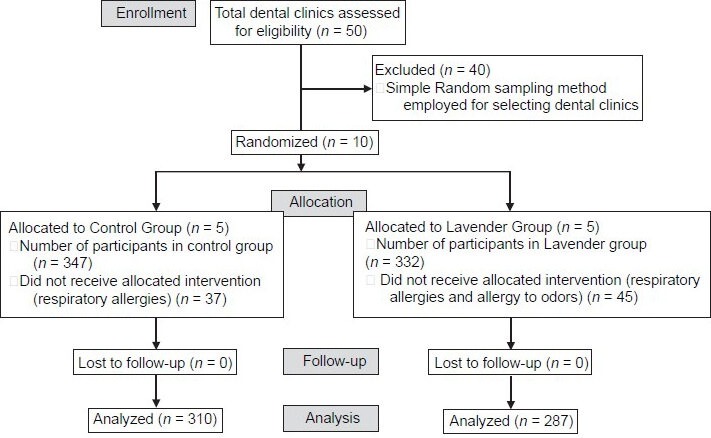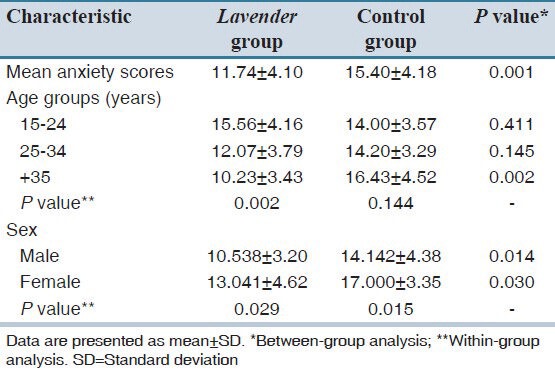Abstract
Objective:
The pure essence of plants (essential oils) provides both psychological and physiological benefits when used accurately and safely. Conventionally, Lavender oil is known for relaxing, carminative, and sedative effects. Hence, an attempt was made to know the effect of Lavender essential oil on dental patient anxiety.
Methods:
The present study included two comparison groups (Lavender and control group), each comprising five dental clinics. In Lavender group, the ambient odor of Lavender essential oil was maintained with the help of a candle warmer in the reception area and in the control group, candle warmer with normal water was used. A total of 597 patients, aged above 18 years were included. A questionnaire comprising demographic information, and a modified dental anxiety scale was given to the patients in waiting room, and data regarding anxiety levels was recorded.
Findings:
Student's t-test (unpaired) showed a significant reduction in anxiety scores of Lavender group compared with the control group. Analysis of variances test showed reduction in anxiety scores as age increased in Lavender group.
Conclusion:
Fragrance of Lavender oil at reception area may effectively reduce the patient's state or current anxiety. This practice on routine usage can improve the quality of dental treatments.
Keywords: Aromatherapy, dental anxiety, dental treatments, Lavender oil
INTRODUCTION
Fear of dentists and dentistry is a common and potentially distressing problem, both for the public and for dental practitioners. Dental anxiety has been defined as an “abnormal fear or dread of visiting the dentist for preventive care or therapy and unwarranted anxiety over dental procedures” and can have physiological, cognitive and behavioral consequences.[1] Its intensity varies from nervousness to dental phobia. It is considered to be the main barrier to successful completion of treatment. Hence, dental anxiety affects the working lives of dental professional potentially compromising performance.
Managing dental anxiety has been suggested as one of the most difficult task for dental practitioners. The most common way of managing is the use of conscious sedation or general anesthesia. However, these procedures do carry some risks, require additional equipment and cannot be applied to the patients with allergies and other medications.[2]
Off late, the previously marginalized therapies are gaining acceptance by general population. Aromatherapy is one such alternative medical approach, which includes the inhaled, absorbed, or ingested use of essential oils for prophylactic treatment.[3,4,5]
The inhalation of different odors in aromatherapy been related to relaxation, alertness, attention, performance, and healing.[6] Aroma of Lavender (Lavandula angustifolia) essential oil has been associated with parasympathetic stimulation of the autonomic nervous system, leading to decreased anxiety, improved mood, and increased sedation.[7] Given the potential effects of essential oils, the goal of the present study was to know the effect of Lavender essential oil on anxiety levels of patients’ awaiting dental procedures in dental office.
METHODS
Simple random sampling method was employed to select 10 dental clinics in Guntur city. Randomly five dental clinics were allotted into Lavender group and other five for the control group. A total of 597 patients aged above 18 years visiting the dental clinic for the first time with dental problems were included. Patients with respiratory allergies and epilepsy were excluded [Figure 1].
Figure 1.

CONSORT diagram of the study
Prior to procedure ethical clearance, the necessary permission from the private practitioner of the selected dental clinics and informed consent from the patients were obtained. In Lavender group, the candle warmers with essential oil diluted (1:1) with water were placed in waiting the hall and activated ½ h before the arrival of the first patient. Patients who were suffering from allergies were told to wait in the reception hall itself which was also furnished to hold patients. In the control group, candle warmer with normal water was used.
The patients, after waiting for 15 min in conditioned waiting rooms, were asked to fill the questionnaire comprising demographic information on age, gender, and modified dental anxiety scale,[3] which is a brief, self-complete questionnaire consisting of five reasonable psychometric questions which summed together to produce a total score ranging from 5 to 25. Answering the questions was completely self-paced.
Student's t-test for determining the difference between the anxiety scores and analysis of variance for determining the variables effecting dental anxiety were used; level of significance was set at 0.05. All variables were calculated with SPSS for windows (SPSS, Chicago, IL, USA) version 18.0.
RESULTS
The mean (standard deviation) age of subjects in Lavender group and control group was 37 (14) years and 33 (9) years, respectively. Gender wise distribution among study groups: In Control group 152 males and 158 females and in Lavender group 139 were males and 148 were females. Statistically significant (P = 0.001) reduction was observed in anxiety scores in Lavender group compared with control group [Table 1]. The patients were divided into three age groups (15–24 years, 25–34 years, 35 years, and above), on comparison of dental anxiety scores between three age groups in Lavender group, there was a statistically significant (P = 0.002) decrease with age in mean anxiety score [Table 1]. Comparison of anxiety scores between genders in Lavender group compared with control group showed statistically significant decrease in anxiety scores of both genders [Table 1].
Table 1.
Comparison of anxiety scores between Lavender and control group

DISCUSSION
The medicinal use of aromatic oils dates back to ancient Egyptian and Chinese cultures. Rene-Maurice Gattefosse, a French chemist experimented with essential oils for wound healing during World War I. However, aromatherapy gained attention during 1980s, when the work on mind-body healing and the emerging field of psychoneuroimmunology stimulated interest in the use of aromatherapy to alleviate emotional and mental distress. It is widely believed that odors have the power to influence emotional states in humans.[8,9]
The reception area in hospitals always has been a highly anxious place for patients. With our controlled experimental study, we have tested the hypothesis that essential oils reduce anxiety levels in patients awaiting dental procedures at dental office. Patients while waiting for dental procedures stimulated with ambient odor of Lavender and compared with the control condition. We have found that patients exposed to Lavender essential oil fragrance had lower level of anxiety, and confirmed the previous notion[5,8] of sedative properties of natural essential oils and extended its use in dental settings.
As the age increases the anxiety scores significantly decreased for Lavender group and it was unchanged in control group similar to the findings of Akbay et al.[10] and Edwards and Fillingim[11] additively females showed significant decrease in anxiety levels than males in both the groups consistent with Toet et al.[12] and Marchand and Arsenault.[13]
Moreover, the aroma of essential oils is effective in reducing moderate and state anxiety than severe and trait anxiety[14] and effective against state anxiety than trait anxiety. In another study by Burnette, used rosemary and Lavender scents on 73 healthy college students during anxiety-provoking tasks and proved that they significantly reduce tension-anxiety and fatigue-inertia ratings.[15]
Itai et al.[16] compared the effects of Lavender, Hiba oil, and control conditions on depression and anxiety in hemodialysis patients. They showed that Hiba oil significantly decreased mean scores on both anxiety and depression, and Lavender significantly decreased mean anxiety scores. These findings were significant independent of personality traits, psychological status, and psychotherapeutic medication for anxiety and sleep.
The mechanism of action of essential oils is unknown in inducing emotional changes. For example, Lavender has been documented to act postsynoptically, and it modulates the activity of cyclic adenosine monophosphate (cAMP). A reduction in cAMP activity is associated with sedation. Linalool, one of the main ingredients of essential Lavender oil, lowered physiological arousal level by means of autonomic deactivation without affecting mood ratings.[3,17,18] Neuroimaging studies have shown that olfactory processing is directly linked to the limbic system including the amygdale and that emotional changes are induced by means of olfactory stimulation.[19] Considering the limitations, the present study was carried out on a small sample, and further no comparisons were done with other antianxiety modalities.
By our study, Lavender is an effective means of reducing current or state anxiety levels and not as an anxiety treatment. This provides evidence favoring the use of Lavender scent in dental settings as a low cost, simple intervention for alleviating dental patient anxiety. The results can be generalized to patients with levels of dental anxiety below the level of phobia who are attending the general dental clinics; also, it warrants extended research on a large scale for evaluating the effectiveness of essential oils in reducing dental anxiety.
Footnotes
Source of Support: Nil
Conflict of Interest: None declared.
REFERENCES
- 1.Kritsidima M, Newton T, Asimakopoulou K. The effects of Lavender scent on dental patient anxiety levels: A cluster randomised-controlled trial. Community Dent Oral Epidemiol. 2010;38:83–7. doi: 10.1111/j.1600-0528.2009.00511.x. [DOI] [PubMed] [Google Scholar]
- 2.Gedney JJ, Glover TL, Fillingim RB. Sensory and affective pain discrimination after inhalation of essential oils. Psychosom Med. 2004;66:599–606. doi: 10.1097/01.psy.0000132875.01986.47. [DOI] [PubMed] [Google Scholar]
- 3.Hosey MT UK National Clinical Guidelines in Pediatric Dentistry. UK National Clinical Guidelines in Paediatric Dentistry. Managing anxious children: The use of conscious sedation in paediatric dentistry. Int J Paediatr Dent. 2002;12:359–72. doi: 10.1046/j.1365-263x.2002.03792.x. [DOI] [PubMed] [Google Scholar]
- 4.Martin GN. The effect of exposure to odor on the perception of pain. Psychosom Med. 2006;68:613–6. doi: 10.1097/01.psy.0000227753.35200.3e. [DOI] [PubMed] [Google Scholar]
- 5.Lehrner J, Marwinski G, Lehr S, Johren P, Deecke L. Ambient odors of orange and Lavender reduce anxiety and improve mood in a dental office. Physiol Behav. 2005;86:92–5. doi: 10.1016/j.physbeh.2005.06.031. [DOI] [PubMed] [Google Scholar]
- 6.Field T, Diego M, Hernandez-Reif M, Cisneros W, Feijo L, Vera Y, et al. Lavender fragrance cleansing gel effects on relaxation. Int J Neurosci. 2005;115:207–22. doi: 10.1080/00207450590519175. [DOI] [PubMed] [Google Scholar]
- 7.Moss M, Cook J, Wesnes K, Duckett P. Aromas of rosemary and Lavender essential oils differentially affect cognition and mood in healthy adults. Int J Neurosci. 2003;113:15–38. doi: 10.1080/00207450390161903. [DOI] [PubMed] [Google Scholar]
- 8.Lis-Balchin M, Hart S. Studies on the mode of action of the essential oil of Lavender (Lavandula angustifolia P. Miller) Phytother Res. 1999;13:540–2. doi: 10.1002/(sici)1099-1573(199909)13:6<540::aid-ptr523>3.0.co;2-i. [DOI] [PubMed] [Google Scholar]
- 9.Robins JL. The science and art of aromatherapy. J Holist Nurs. 1999;17:5–17. doi: 10.1177/089801019901700102. [DOI] [PubMed] [Google Scholar]
- 10.Akbay Oba A, Dülgergil CT, Sönmez IS. Prevalence of dental anxiety in 7- to 11-year-old children and its relationship to dental caries. Med Princ Pract. 2009;18:453–7. doi: 10.1159/000235894. [DOI] [PubMed] [Google Scholar]
- 11.Edwards RR, Fillingim RB. Age-associated differences in responses to noxious stimuli. J Gerontol A Biol Sci Med Sci. 2001;56:M180–5. doi: 10.1093/gerona/56.3.m180. [DOI] [PubMed] [Google Scholar]
- 12.Toet A, Smeets MA, van Dijk E, Dijkstra D, van den Reijen L. Effects of Pleasant Ambient Fragrances on Dental Fear: Comparing Apples and Oranges. Chemosens Percept. 2010;3:182–89. doi: 10.1007/s12078-010-9078-9. [DOI] [PMC free article] [PubMed] [Google Scholar]
- 13.Marchand S, Arsenault P. Odors modulate pain perception: A gender-specific effect. Physiol Behav. 2002;76:251–6. doi: 10.1016/s0031-9384(02)00703-5. [DOI] [PubMed] [Google Scholar]
- 14.Muzzarelli L, Force M, Sebold M. Aromatherapy and reducing preprocedural anxiety: A controlled prospective study. Gastroenterol Nurs. 2006;29:466–71. doi: 10.1097/00001610-200611000-00005. [DOI] [PubMed] [Google Scholar]
- 15.Burnett KM, Solterbeck LA, Strapp CM. Scent and mood state following an anxiety-provoking task. Psychol Rep. 2004;95:707–22. doi: 10.2466/pr0.95.2.707-722. [DOI] [PubMed] [Google Scholar]
- 16.Itai T, Amayasu H, Kuribayashi M, Kawamura N, Okada M, Momose A, et al. Psychological effects of aromatherapy on chronic hemodialysis patients. Psychiatry Clin Neurosci. 2000;54:393–7. doi: 10.1046/j.1440-1819.2000.00727.x. [DOI] [PubMed] [Google Scholar]
- 17.Butje A, Repede E, Shattell MM. Healing scents: An overview of clinical aromatherapy for emotional distress. J Psychosoc Nurs Ment Health Serv. 2008;46:46–52. doi: 10.3928/02793695-20081001-12. [DOI] [PubMed] [Google Scholar]
- 18.Heuberger E, Redhammer S, Buchbauer G. Transdermal absorption of (-) -linalool induces autonomic deactivation but has no impact on ratings of well-being in humans. Neuropsychopharmacology. 2004;29:1925–32. doi: 10.1038/sj.npp.1300521. [DOI] [PubMed] [Google Scholar]
- 19.Zald DH, Pardo JV. Functional neuroimaging of the olfactory system in humans. Int J Psychophysiol. 2000;36:165–81. doi: 10.1016/s0167-8760(99)00110-5. [DOI] [PubMed] [Google Scholar]


